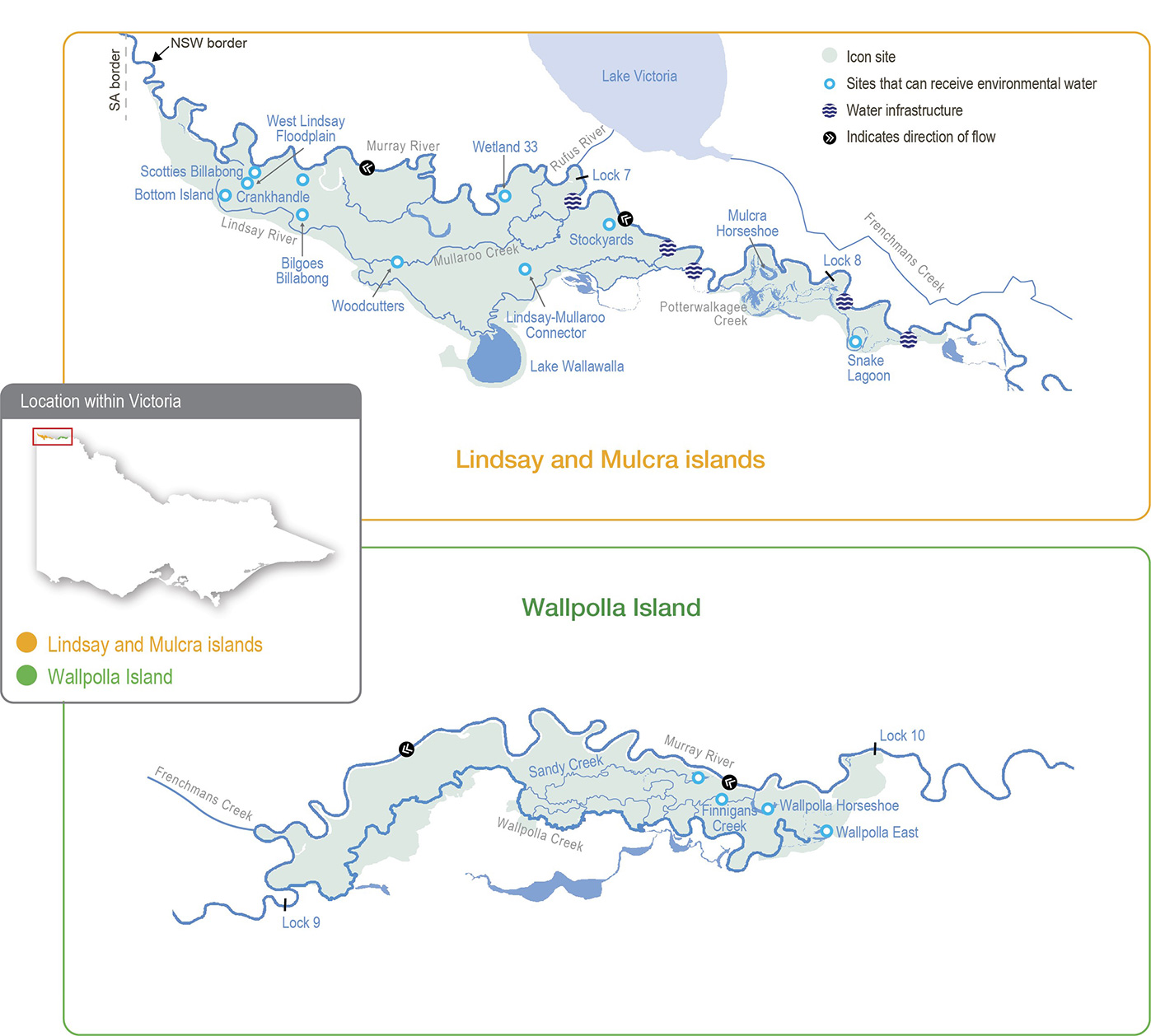The Lindsay, Mulcra and Wallpolla islands floodplain is characterised by a network of permanent waterways, small creeks and wetlands. The Lindsay River, Potterwalkagee Creek and Wallpolla Creek form the southern boundaries of the site and create large floodplain islands with the Murray River to the north.
In their natural state, these waterways and wetlands would regularly flow and fill in response to high water levels in the Murray River. Large floods still occur, but major storages in the upper reaches of the Murray River system and extraction for consumptive use have reduced the frequency of small to moderate-sized floods.
Flows in the mid-Murray River system are regulated through a series of weir pools. The weir pools are colloquially called locks in reference to structures at the weirs that allow vessels to navigate from one weir pool to the next. The weir pools are primarily managed as small water storages to ensure adequate water levels for off-stream diversion via pumps and regulated channels.
Water is diverted from weir pool 9 in the Murray River to Lake Victoria, where it is stored for later use to meet South Australian water demands. The diversion causes water to bypass Murray River weir pools 7 and 8, and at times it can significantly impact flow in those reaches.
In recent years, water levels in weir pools 7 and 8 have been managed to achieve ecological benefits in the Murray River channel. For example, weir pool levels have been raised during winter and spring and then lowered during summer and autumn to mimic the seasonal river flow. The raising and lowering provide greater environmental benefits than a stable weir pool because it wets and dries off-channel habitats and creates more variable flow patterns in the Murray River and connected floodplain streams. Changes in water levels during appropriate seasons help establish fringing vegetation in shallow margins of the river channel and promote the cycling of nutrients and carbon as conditions fluctuate between wet and dry.
Static weir pool levels and reduced flow in the Murray River have a big effect on the flows in the Lindsay River and Potterwalkagee Creek. When the natural flow increases and/or when water levels in weir pools 7 and 8 are raised above the full supply level, the upper Lindsay River starts flowing (Lock 7) and flow to Potterwalkagee Creek increases (Lock 8). When weir pools are lowered, flow to both the Lindsay River and Potterwalkagee Creek ceases. Mullaroo Creek on Lindsay Island is less affected by weir pool levels, and flow is controlled independently through the Mullaroo Creek regulator, which connects the creek and the Murray River. Moderate lowering of the lock 7 weir pool level has little effect on Mullaroo Creek, but lowering more than 0.5 m below full supply level makes it difficult to deliver the recommended minimum flow of 600 ML per day that is required to maintain fast-flowing habitat for native fish, especially Murray cod.
Fluctuation of weir pool levels is a major consideration for jurisdictions managing flow in the Murray River and the anabranch waterways of Lindsay, Mulcra and Wallpolla islands. Environmental objectives and associated water regimes for the Murray River sometimes conflict with those for the Lindsay, Mulcra and Wallpolla anabranch systems. Responsible agencies in Victoria and NSW and the Murray-Darling Basin Authority collaboratively plan how to effectively manage weir pools and flows to floodplain habitats.
